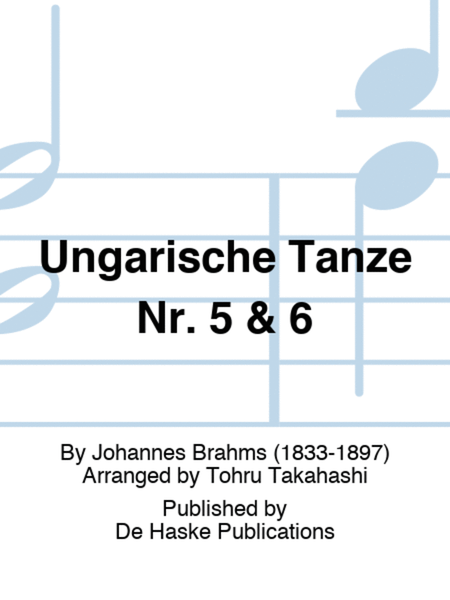Ungarische Tänze Nr. 5 & 6
Hungarian Dances Nos. 5 & 6
-
Ships in 2 to 3 weeks
Details
Description
SKU: BT.DHP-1114946-010
Hungarian Dances Nos. 5 & 6. Composed by Johannes Brahms. Arranged by Tohru Takahashi. Great Classics. Transcription. Set (Score & Parts). Composed 2010. De Haske Publications #DHP 1114946-010. Published by De Haske Publications (BT.DHP-1114946-010).9x12 inches. English-German-French-Dutch.
Fascinated by the expressive power and spirit of the gypsy music from Hungary, Brahms used mainly traditional melodies in his Hungarian Dances as well as themes from compositions in similar musical styles. No. 5 and No. 6 are the most well-known of his Hungarian Dances and are popular as encores at the New Year’s Concert of the Vienna Philharmonic.
Fasziniert von der Ausdruckskraft und Lebendigkeit der Zigeunermusik“ aus Ungarn, verwendete Brahms für die meisten seiner Ungarischen Tänze traditionelle Melodien und Themen aus Kompositionen in diesem Stil. Besonders die Tänze Nr. 5 und Nr. 6 sind heute noch weit über die Grenzen der klassischen Musik hinaus bekannt und beliebte Zugabenummern bei den Neujahrskonzerten der Wiener Philharmoniker.
Johannes Brahms a composé ses Danses hongroises entre 1858 et 1869. Des vingt-et-une danses qu’il écrivit pour piano quatre mains, il n’en orchestra lui-même que quelques-unes ; les autres ayant été transcrites par d’autres compositeurs, dont Anton n Dvoøák. Fasciné par la puissance expressive et la fougue de la musique tzigane hongroise, Brahms lui emprunta quelques airs et mélodies, qu’il noua dans ses danses. Parmi les plus connues, on citera les Danses hongroises n° 5 & 6, magistralement arrangées pour Orchestre d’Harmonie par Tohru Takahashi.
Aff ascinato dal grande potere espressivo e dallo spirito della musica gitana ungherese, nelle Danze Ungheresi Brahms utilizzò soprattutto melodie tradizionali e temi tratti da composizioni scritte in uno stile musicale simile. La numero 5 e 6 sono le Danze Ungheresi più note e sono spesso eseguite come bis nel Concerto di Capodanno dei Wiener Philarmoniker.

 Share
Share